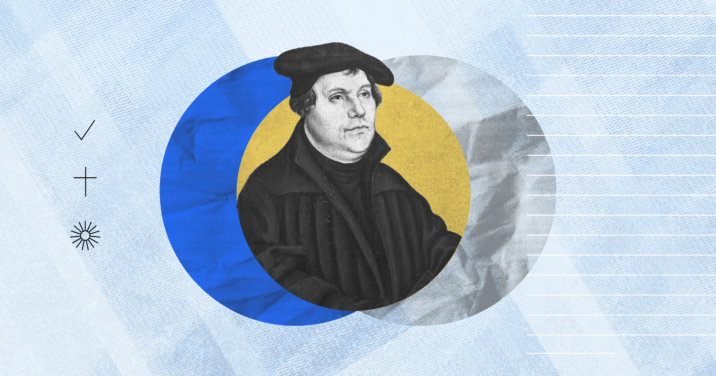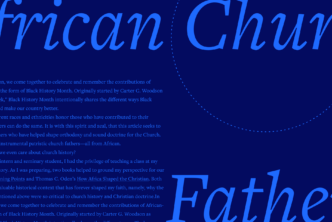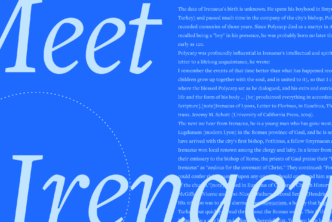For five hundred years, the term “Lutheran” has served variously as a badge of confession for a specific definition of Christian, for Martin Luther’s supporters, as a word of insult used by foes to condemn a variety of views opposed to their own, or as a merely cultural designation for those whose thought has little to do with Luther’s but who have inherited adherence to his ecclesiastical tradition.
Table of contents
The Reformation
In October 1517, Martin Luther proposed a debate over the theology and practice of indulgences, a practice that allegedly offered not only release from the temporal punishment of purgatory but also forgiveness of eternal guilt. His ninety-five theses on indulgences reflected his pastoral concern as an Augustinian Brother for consciences deceived by this practice. Defenders of the papacy regarded the theses’ overall argument as a threat to papal authority. This led them to excommunicate Luther and his followers, who then organized their own distinct church. This, in turn, led other Reformers to do the same.
The churches that claim to follow Luther’s message have taken shape in four major forms.
- The territorial churches of central and northern Europe became linked to the political establishment of many German and Nordic principalities.
- The churches in areas of eastern Europe—Slovakia, Hungary, Poland, Romania—endured a history of persecution from the seventeenth-century Counter-Reformation to modern National Socialist and Soviet oppression.
- Immigrants from the European churches above formed churches in the Americas, South Africa, and Australia.
- Following earlier Lutheran attempts at foreign missions, a Danish–German missionary enterprise established the first permanent Lutheran church in what is called the Majority world, in south India, in the early eighteenth century.
Within these churches, some have remained faithful to the teaching of Luther, as summarized in the Book of Concord (1580). It contains confessions of faith by Luther, his right-hand support and conversation partner at the University of Wittenberg, Philip Melanchthon (above all, the Augsburg Confession [1530]), and a group of their students who consolidated Wittenberg teaching in the Formula of Concord (1577).
What Lutherans believe
Unmerited grace
By 1521/1522, Luther’s call for reform of public teaching and his understanding of the biblical message matured into a core of doctrine that he continued to refine for the last quarter-century of his life. He reacted against the medieval understanding of being Christian, an understanding he absorbed from his parents and teachers, from his university instructors, and from his superiors in the Augustinian cloister in Erfurt. This understanding had emerged from the structure of traditional Germanic religion; it found the key to the relationship with divine powers in the human performance of sacred acts of ritual. The liturgy surrounding the Lord’s Supper, the “mass,” was redefined as a sacrifice performed by the local priest, placing the hierarchy (with papal leadership at its head) in the key role of mediating and thus dominating the religious life of Christians. The missionaries also had taught that the world is held together by human performance of an eternal law, with the help of God’s grace. Human action directed toward God provided the key to the godly life.
Although Luther’s priests and instructors taught that God’s grace was necessary as an aid for producing good works that would reconcile him with God, he grew up with the conviction that he had never done enough to merit this grace. A combination of factors caused him to redefine what it meant to be Christian. His own personality led him to notice the intensely personal and emotional nature of God depicted in Scripture. His instruction in the philosophy of the fourteenth-century thinker William of Ockham threw him into despair, with its idea that he had to do his best to win the grace necessary to make his own works pleasing to God. However, Ockham’s insistence that God is almighty and freely determines all things—in accord with the covenants he had set down for human beings—and his high appreciation of the goodness of the created order shaped Luther’s approach to the Bible. So did the revival of Hebrew and Greek by the so-called “biblical humanists,” including Desiderius Erasmus. Luther seized the tools of Erasmus and Johannes Reuchlin, who introduced Hebrew studies to northern Europe, in his probing of Scripture.
It was there, in Scripture, that Luther found that God approaches sinners before they make any move in his direction. The religious or sacred activities of the sacrifice of the Mass and other rituals do not generate a person’s relationship with God. Instead, God approaches his human creatures with his promise of forgiveness and new life in Christ. Luther saw that it was not human performance of activities prescribed by the church that shapes the relationship between God and his chosen people, but God’s speaking to his people this word of pardon and peace based on Jesus’s dying and rising for them.
Christ alone
Jesus Christ lay at the center of Luther’s proclamation of God’s Word. In his person as fully God, the Second Person of the Trinity became fully human, born of the virgin Mary. The Wittenberg Reformer focused on the death and resurrection of Jesus, seeing—in accord with Romans 4:25—his death as the laying of believers’ sins in his tomb (Rom 6:3–5) and his resurrection as the restoration of righteousness, setting believers on the path of living out the life Christ had modeled as the truly human life.
Luther taught that Christ satisfied the demands of God’s law on sinners, who had to die because the wages of sin is death (Rom 6:23a). As he wrote in his Small Catechism, this was not a commercial “gold and silver” transaction, as Peter had written (1 Pet 1:8), but the price of the soldier on the battlefield, giving his life for his chosen people.
His resurrection then restored sinners to their being children of God, who “fear, love, and trust in God above all else,” as Luther explained the first commandment. Luther believed that Christians should know that God chose them before the foundation of the world (Eph 1:3–11) as part of their confidence in God’s unconditional promise of new life through Christ. He rejected attempts to speculate beyond what Scripture says regarding those who do not trust Christ, placing the full weight of God’s condemnation on their unbelief and affirming that God is in no way responsible for evil.
Passive and active righteousness
The Wittenberg Reformers defined human righteousness as twofold. They distinguished what makes us truly human in relationship to God as a righteousness given to us in our passivity, as parents give life and identity to their children. God reasserts his claim as Creator by becoming Redeemer or Liberator and Sanctifier as he gives new birth through his re-creative word. It comes as the promise of the benefits won by Christ for his people on the cross and in his resurrection. Because God is promising, what lies in the future of the promise of reconciliation with God and forgiveness of sins becomes present reality. God’s promise, his gospel, actually effects a new birth, a new creation. The one who trusts the promise and the Promiser is defined first of all by that trust. Luther defined the original sin as Eve’s and Adam’s doubting God’s word in Eden, as their defiance of his Lordship and refusal to trust his word. All transgressions of God’s design for human life in his law stem from this failure to trust him and what he has told us. Luther struggled against the devil, the very personal Murderer and Liar, with whom he experienced combat every day, driving him to repentance and renewal of his faith in the midst of these struggles (in German, Anfechtungen).
Human righteousness involves, to be sure, also the response of the reborn child of God to this heavenly Father. Parents always have expectations of their children. God expects thanks and praise as well as obedience that leads to loving and serving other human beings and the rest of God’s creation. Luther called these human actions that proceed from trust and recognize God’s gift of passive righteousness “active righteousness.” Luther emphasized that God recognized that “it is not good that the man should be alone” (Gen 2:18), and so he lifted up human community. In his Small Catechism’s treatment of the Apostles Creed, he had children confess that “God has made me together with all creatures” and that the Holy Spirit has given “me” faith “just as he calls, gathers, enlightens and makes holy the whole Christian church on earth.” Therefore, those who trust that God has made them children trust his protection and follow his commands in self-sacrificial love and service to others.
Law and gospel
In coordination with his teaching of the two kinds of human righteousness, passive and active, as a description of being human, Luther highlighted God’s speaking to us in two ways. He took the words “law” and “gospel” to distinguish God’s description of his expectations of human beings—“the law”—from his presentation and actualization of his re-creative promise in Jesus Christ, his promise of forgiveness and new life as God’s child. Luther strove to present hearers of his Word from thinking in any way that their own performance of his will could establish or maintain their relationship with him, for God’s gracious love of his chosen people is always the only cause, basis, and source of their relationship. But like human parents, his love not only elicits but expects responses of the kind for which he created his human creatures.
Luther found that God speaks his word of life in oral, written, and sacramental forms. He attributed to the conveying of the gospel the very power of salvation (Rom 1:16), for his Ockhamistic background had taught him that God’s speaking does not cease to be creatively active. Therefore, he believed that the gospel of Christ not only points to a heavenly reality in Platonic fashion but that it actually effects what it says when it communicates the promise of forgiveness and new life. For Christians throughout the ages, that has come in oral fashion, through preaching, through the pronouncement of forgiveness in formal or informal absolution, and in what Luther called “the mutual conversation and consolation” of Christians with one another.
God’s Word comes authoritatively, as the source of oral and sacramental bestowal of God’s promise. Luther asserted that “God is nowhere more present than in Holy Scripture,” for the Holy Spirit had not only guided the prophets and apostles in their composition of the Bible, but he also is active in carrying out its words of admonition or condemnation as well as of its life-restoring promise today. Readers of Christian literature of all kinds can lift from the printed page this word of life when it is clearly spelled out—although Luther also emphasized the importance of the “living voice of the gospel,” the human communication in personal, oral form of the witness of Christ.
Sacraments
Luther viewed God as a multi-media communicator and found it delightful that God had place his promise in different forms. For example, he believed that the word of new life in Christ is communicated with outward signs, in baptism and in the Lord’s Supper. He assured the children learning his Small Catechism that “it is not the water” that gives this new birth (John 3:3) or that saves (1 Pet 3:21), but “the Word of God” and faith in his promise of forgiveness establish the covenant between God and the one baptized. It is not the eating and drinking of the bread and the wine that convey Christ’s body and blood that are given and shed “for you,” but the word of Christ and the trust that his death and resurrection work “for me” that deliver forgiveness, life, and salvation.
It is sometimes said that in various ways Luther’s theology is halfway between medieval (or “Roman”) Catholicism and Reformed theology. This is not true. The relationship of Luther to those who criticized his theology is better described as triangular rather than linear. The former configuration is often based on his sacramental theology. His fierce criticism of Roman Catholic views of the Mass as a sacrifice involving human performance of a God-pleasing work, his rejection of the withholding of Christ’s blood in the wine of the sacrament, and his condemnation of any reliance on the material aspects of God’s sacramental communication instead of on the words of forgiveness set him apart from Roman Catholicism. Distinguishing him as sharply from the Reformed were his just as strongly expressed trust in God’s ability to give the faithful his body and blood in or with (he believed that the prepositions cannot convey the full mystery of Christ’s presence) the elements of bread and wine, as well as his confidence that God’s Word in the sacraments has the power to work his will on earth. Although most discussion has revolved around the question of the presence of Christ in the Supper, the question of its power to actually effect forgiveness and a reborn status as God’s child is just as important as differences over his presence.
Communal life and vocation
Luther’s understanding of the active life of Christian obedience arose out of his understanding of God’s calling his people to live together in human community. He viewed this communal life from the standpoint of medieval social theory. It divided society into three “estates” or walks of life: the church, society, and the household with its familial and economic obligations. In each of these life situations, individuals had “offices,” that is, responsibilities: positions with specific functions of service. Those in the church were said to have “callings” as monks, nuns, or priests.
Luther broadened the definition of calling and came to see that all Christians had tasks to which God called them in family and economic life, societal or political activities, and the church. Medieval theologians had counted the callings of the hierarchy, the church, as the key to social living. Luther placed the family as the foundation of communal life.
The church, liturgy, and worship
Luther taught that all Christians are priests of God, with direct access in prayer to their Creator and Liberator, and with the calling to bring God’s Word of forgiveness and life to others in mutual conversation and consolation and in witness to those outside the faith.
At the same time he treasured the office of pastor, with its obligation to proclaim law and gospel and to bring the impenitent to repentance and the despairing to the comfort of God’s unconditional promise of forgiveness and new life in Christ. He also treasured the liturgy, in which the proclamation of God’s Word and his people’s praise of him are experienced by the community, the church. Luther allowed some freedom for local churches to determine worship form, but he largely preserved the medieval form for worship—with the exception of those elements that suggested salvation through human performance.
The church exists first of all in the local congregation, where, in the words of the Augsburg Confession, the gospel is proclaimed and the sacraments are used properly. The Wittenberg theologians also recognized that the community of believers exists in regional or territorial churches, in all churches confessing the Trinity throughout the world, and in the fellowship of living and departed believers.
Saint and sinner
Luther recognized the continuing struggle imposed by the devil and found comfort in the apostle Paul’s confession in Romans 7 of his own battle against the system of sin that gnawed daily at his faith. Like Paul, Luther threw himself on Christ alone (Rom 7:4–8:1). He refused to speculate about the timing and the process of Christ’s return to judge and to liberate his people, but his strong sense of the eschatological battle with the devil, the world, and his own sinful desires filled his thought.
Developments in Lutheranism
Early modern Lutheranism
Throughout the past half-millennium, those claiming to be Lutherans have expressed their faith with varying degrees of faithfulness to Luther and the Book of Concord. Most held the conviction that Scripture alone is the authoritative source for the truth; most practiced a commitment to pastoral care that calls for repentance and also comforts with Christ’s promise. In the seventeenth century, Lutheran theologians largely remained faithful to Luther’s core while returning to greater use of allegory in biblical interpretation and of Aristotelian method in contemporary form. This method enabled them to exchange ideas with Roman Catholic and Reformed theologians. Sophisticated theology intertwined with popular devotion in the seventeenth century. Johann Gerhard (1582–1637), professor at Jena, exemplified the combination of theological thoroughness and the cultivation of piety with his popular devotional works. Abraham Calov (1612–1686), prominent Wittenberg professor, not only composed a twelve-volume dogmatics text but also a study Bible.
In reaction to the lack of pious practice among many in the territorial churches of northern and central Europe, late-seventeenth century leaders encouraged faithful Bible reading, individually and in small groups. Although leading theologians had always encouraged pious living, these “Pietists” developed special forms of devotion and service. They were active especially in social care for the needy and in foreign missions.
The love of music modeled by Luther blossomed among Lutherans. There are the hymns of Paul Gerhard, for example, a pastor who sacrificed his position in Berlin under pressure to compromise his understanding of the Lord’s Supper by the “Great Elector,” Friedrich Wilhelm. There are also the secular and sacred music of Heinrich Schütz (1585–1672) and of Johann Sebastian Bach (1685–1750). All three consciously used Luther’s thought in their work.
Lutherans in society
Despite frequent submission to secular powers and secular trends of thought, Lutherans have also opposed tyranny, from Luther’s own disciples’ resistance to the incipient Counter-Reformation; for example, in the Magdeburg Confession (1550), or the opposition to National Socialism of Dietrich Bonhoeffer (1906–1945) or Hermann Sasse (1895–1976). Lutherans have also led in efforts to aid the poor and needy. In India, for example, certain Lutherans have pioneered “Dalit theology.”
Lutheran theologians throughout the world continue today to attempt to apply the biblical message effectively to the personal crises and pastoral dilemmas of the people of their times and places, and to do so with the aid of the insights of Martin Luther, as well as his colleagues (such as Philip Melanchthon) and their students.
Lutheranism today
Worldwide, Lutheran churches are organized into two associations. Most are members of the Lutheran World Federation, with headquarters in Geneva. It represents a spectrum of positions on major doctrinal and social positions. The smaller International Lutheran Council, headquartered in Saint Louis, brings together conservative churches strongly committed to the Book of Concord.
The Evangelical Lutheran Church in America, a merger of several strands of Lutheran churches formed by immigrants in the nineteenth century, is the largest Lutheran denomination in North America. The Lutheran Church–Missouri Synod—which has German, Slovak, and Finnish roots—is the second largest Lutheran denomination, followed by the Wisconsin Evangelical Lutheran Synod and the North American Lutheran Church. The last is composed of congregations that left the Evangelical Lutheran Church in America after its merger. Other congregations that left the ELCA are linked in a less formally organized association, Lutheran Congregations in Mission for Christ. Earlier in the mid-twentieth century, the Association of Lutheran Congregations and The Association of American Lutheran Churches formed out of circles from the ELCA or its predecessor churches. Some thirty other Lutheran Churches have smaller memberships.
Popular Lutheran theologians
- Oswald Bayer
- Dietrich Bonhoeffer
- Gerhard Forde
- Paul Hinlicky
- Hans-Joachim Iwand
- Kazoh Kitamori
- Christoph Schwöbel
- Hermann Sasse
Dr. Kolb recommends these books for further reading:
The Book of Concord, the Confessions of the Evangelical Lutheran Church, ed. Robert Kolb and Timothy J. Wengert (Minneapolis: Fortress, 2000).
Theology the Lutheran Way, trans. Jeffrey G. Silcock and Mark C. Mattes (Grand Rapids: Eerdmans, 2007)
Debating the Sacraments: Print and Authority in the Early Reformation, Amy Nelson Burnett (Oxford/New York: Oxford University Press, 2019)
Theology Is for Proclamation, Gerhard O. Forde (Minneapolis: Fortress, 1990).
The Genius of Luther’s Theology: A Wittenberg Way of Thinking for the Contemporary Church, Robert Kolb and Charles P. Arand (Grand Rapids: Baker, 2008).
Books written or recommended by Robert Kolb
Luther and the Stories of God: Biblical Narratives as a Foundation for Christian Living
Regular price: $23.99
The Genius of Luther’s Theology: A Wittenberg Way of Thinking for the Contemporary Church
Regular price: $23.99
Build your Lutheran resources with these curated libraries
Related articles
- The Spirit of Christ: The Holy Spirit in the Lutheran Tradition
- Law & Gospel: How Martin Luther Wanted You to Read Your Bible
- Martin Luther’s Legacy Lives on in This New Documentary






